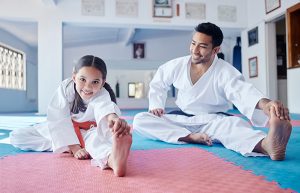Martial Arts Class Structure
In the realm of martial arts, the structure of a class plays a pivotal role in enhancing student engagement and facilitating effective learning. A well-organised class not only imparts technical skills but also fosters discipline, respect, and a lifelong passion for the art.
A poorly structured class, on the other hand, can lead to disengagement, ineffective training, and even safety issues. Whether you are teaching children, teenagers, or adults, ensuring that your class follows a well-thought-out structure is essential to keeping students motivated, challenged, and consistently improving.
This article will explore the elements of an effective martial arts class structure and provide a detailed example of how a typical session can be planned to maximise engagement and skill development.
Understanding Your Students
Every student is unique, bringing their own learning styles and paces to the dojo. Recognising these differences is crucial. Some students are visual learners who need to see a technique demonstrated multiple times before they can execute it, while others are kinaesthetic learners who learn best by physically performing movements.
Additionally, age plays a significant role in structuring a class. Younger students may require shorter, more dynamic activities to maintain their attention, whereas adult learners often prefer a more structured and detailed breakdown of techniques.
By understanding these variations, an instructor can tailor their approach to ensure that each student remains engaged and motivated throughout the class.
Setting Clear Objectives
Every martial arts session should have clear objectives. Without a goal, students may feel like they are training without purpose. A effective martial arts class structure should set specific targets, such as:
- Learning a new kick or strike
- Improving speed and agility
- Enhancing sparring strategies
- Developing self-defence techniques
These objectives should align with the overall curriculum so that students are consistently progressing towards their next belt level or skill milestone.
The Importance of Warm-Up Activities
 A proper warm-up is the foundation of any martial arts class. It prepares the body for the physical demands ahead and reduces the risk of injury. A well-designed warm-up should last 10–15 minutes (however younger students can get by with 5 minutes) and include:
A proper warm-up is the foundation of any martial arts class. It prepares the body for the physical demands ahead and reduces the risk of injury. A well-designed warm-up should last 10–15 minutes (however younger students can get by with 5 minutes) and include:
- Light aerobic exercises – jogging, skipping, or jumping jacks to increase heart rate
- Joint rotations – neck, shoulders, wrists, hips, knees, and ankles to improve flexibility and mobility
- Dynamic stretching – leg swings, arm circles, and hip openers to prepare the muscles for movement
- Balance and coordination drills – essential for martial arts techniques such as kicking and footwork
Skipping this stage or rushing through it can lead to stiffness, increased risk of injury, and poor performance during the class. As part of your martial arts class structure, try to vary the warm ups. Sometimes add games, keep things high energy to stop people skipping the warm up and potentially injuring themselves by not activating their bodies correctly.
Delivering Technical Instruction Effectively
The core of any martial arts class structure lies in the technical instruction. This is where students learn and refine their techniques, whether it’s striking, blocking, grappling, or footwork. To ensure effectiveness:
- Explain the technique clearly and concisely
- Demonstrate it slowly and at full speed
- Break it down into steps for beginners
- Allow students to ask questions and clarify doubts
- Provide corrections and refinements where necessary
An effective instructor will adjust their teaching style to match the level and experience of the students in the class.
Drill Practices: The Key to Mastery
Martial arts techniques require repetition to become second nature. Drills reinforce skills and build muscle memory, allowing students to execute techniques instinctively during sparring or real-world scenarios.
Drills can take several forms, including:
- Solo drills – practising techniques in the air or on a bag
- Partner drills – working with a classmate to develop timing and accuracy
- Pad work – striking focus mitts, kicking shields, or heavy bags for power and precision
It is important to balance repetition with variety to keep students engaged while ensuring they develop competency in their techniques.
Sparring Sessions: Applying Skills in Real Time
Sparring is one of the most valuable aspects of martial arts training as it allows students to test their techniques in a controlled environment. However, many students—especially beginners—find sparring intimidating. To create a positive sparring experience:
- Ensure students are paired with appropriate partners based on skill level and size
- Emphasise control and technique over brute force
- Reinforce safety protocols and require protective gear
- Encourage feedback and self-reflection after each round
Sparring should be introduced gradually and adapted based on the student’s progression.
Incorporating Games and Challenges for Engagement
 Martial arts is a discipline that requires focus and hard work, but that doesn’t mean classes should be rigid and overly serious. Adding games and challenges can make training more enjoyable while reinforcing important skills.
Martial arts is a discipline that requires focus and hard work, but that doesn’t mean classes should be rigid and overly serious. Adding games and challenges can make training more enjoyable while reinforcing important skills.
For younger students, games like reaction drills, agility courses, or team-based challenges can help improve reflexes and movement. For older students, friendly competitions such as who can hold a stance the longest or execute the fastest combination can add a fun yet competitive element.
Cool-Down and Stretching: Preventing Injuries and Aiding Recovery
A cool-down session is just as important as a warm-up. It helps to relax the muscles, prevent stiffness, and aid in recovery. A proper cool-down includes:
- Light movements – slow jogging or shadowboxing to gradually lower heart rate
- Static stretching – holding stretches to improve flexibility and release tension
- Deep breathing exercises – to promote relaxation and focus
Neglecting this stage can lead to muscle tightness and increase the risk of injury.
Providing Feedback and Assessments
Feedback is crucial in martial arts training. Students need to know what they are doing well and what they need to improve. A good instructor provides:
- Immediate feedback – correcting mistakes as they occur
- Detailed assessment – reviewing overall performance after class
- Encouragement and motivation – recognising progress and effort
Assessments through grading tests and belt promotions give students clear milestones to strive for, keeping them motivated and engaged.
End-of-Class Reflection and Programme Focus
After the physical portion of the class has concluded, it’s important to take a few minutes to reflect on what was covered and discuss the academy’s specific programme goals. This is the perfect time to reinforce the mindset and values that martial arts instils, such as discipline, perseverance, and respect. This is an essential item within the martial arts class structure. This is where you are able to blend the physical and philosophical aspects of your programme.
Many academies run structured programmes that go beyond just physical techniques. These may include:
- Character development themes – e.g., focusing on confidence, focus, leadership, or perseverance for the month
- Goal setting – discussing students’ short-term and long-term martial arts goals
- Challenges outside of the dojo – addressing personal obstacles such as school challenges, work stress, or maintaining a balanced lifestyle
- Community engagement – encouraging participation in academy events, tournaments, or charity initiatives
Taking a few minutes at the end of class to check in with students, encourage discussion, and offer motivation can greatly improve their engagement and retention. This also helps students see the broader impact of martial arts in their daily lives beyond physical training.
Example Martial Arts Class Structure
Here’s a sample structure for a 60-minute martial arts class designed for intermediate students:
-
- Warm-Up (5 minutes)
- Light jogging and dynamic stretching
- Shadowboxing with basic strikes and movements
- Technical Instruction (15 minutes)
- Teaching new kicking combinations
- Breaking down each movement step-by-step
- Drills (15 minutes)
- Partner pad drills focusing on accuracy and power
- Footwork drills to improve movement and agility
- Sparring (10 minutes)
- Light-contact sparring rounds with controlled techniques
- Instructor feedback between rounds
- Cool-Down and Stretching (5 minutes)
- Slow shadowboxing to bring heart rate down
- Static stretching for flexibility and injury prevention
- Programme Discussion (10 minutes)
- Discussion on programme goals or character development theme
- Encouragement and goal-setting for next class
- Addressing challenges students may face outside of the dojo
- Warm-Up (5 minutes)
This structure ensures students remain engaged while developing their skills systematically.
Conclusion
A well thought out martial arts class structure provides a balanced mix of technical instruction, practical application, and engagement strategies to keep students motivated. From warm-ups to sparring, every element plays a role in maximising learning and retention.
By understanding students’ needs, maintaining consistency, and continually refining teaching methods, instructors can create an environment that fosters both skill development and passion for martial arts.
FAQs
- How long should a martial arts class be?
- Most classes range from 45–90 minutes, depending on the level and intensity.
- What’s the most important part of a class structure?
- A well-balanced class includes warm-ups, technical drills, sparring, and cool-downs to ensure comprehensive training.
- How can I make martial arts classes fun for kids?
- Incorporate games, challenges, and interactive drills while maintaining discipline.
- How often should students spar?
- Sparring should be introduced gradually, starting once a week and increasing as students gain confidence and skill.
- How do you keep students motivated in martial arts?
- Set clear goals, provide regular feedback, and create a positive and supportive learning environment.
By following a structured and engaging approach, martial arts instructors can ensure that their students remain enthusiastic and continue their journey towards mastery.





